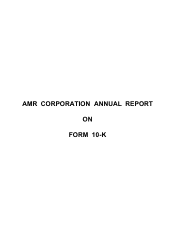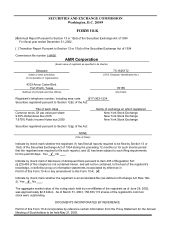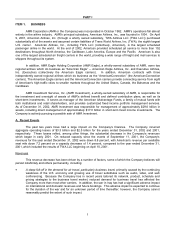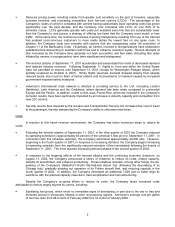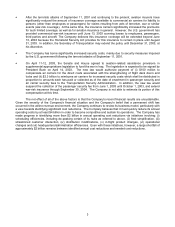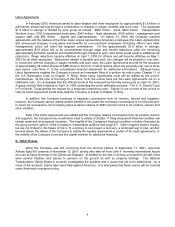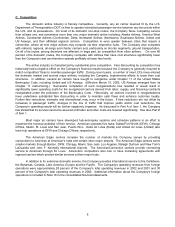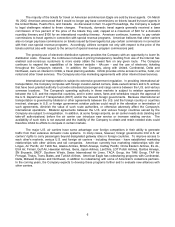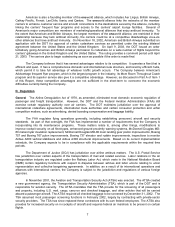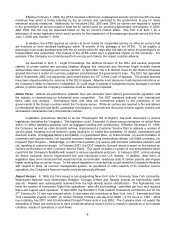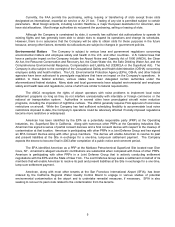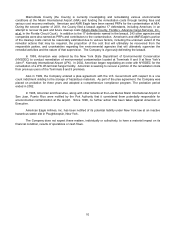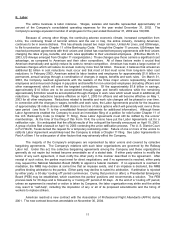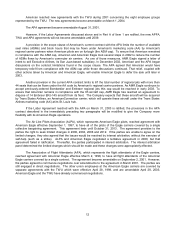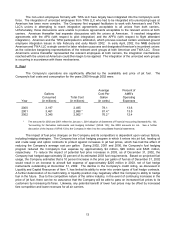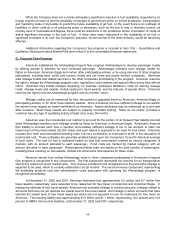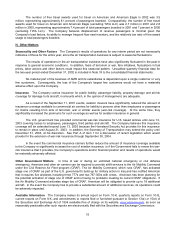American Airlines 2002 Annual Report Download - page 7
Download and view the complete annual report
Please find page 7 of the 2002 American Airlines annual report below. You can navigate through the pages in the report by either clicking on the pages listed below, or by using the keyword search tool below to find specific information within the annual report.
5
C. Competition
The domestic airline industry is fiercely competitive. Currently, any air carrier deemed fit by the U.S.
Department of Transportation (DOT) is free to operate scheduled passenger service between any two points within
the U.S. and its possessions. On most of its domestic non-stop routes, the Company faces competing service
from at least one, and sometimes more than one, major domestic airline including: Alaska Airlines, America West
Airlines, Continental Airlines (Continental), Delta, Northwest Airlines (Northwest), Southwest Airlines, United and
US Airways, and their affiliated regional carriers. Competition is even greater between cities that require a
connection, where all nine major airlines may compete via their respective hubs. The Company also competes
with national, regional, all-cargo and charter carriers and, particularly on shorter segments, ground transportation.
On all of its routes, pricing decisions are affected, in large part, by competition from other airlines. On over 80
percent of its domestic routes, the Company competes with airlines that have cost structures significantly lower
than the Company's and can therefore operate profitably at lower fare levels.
The airline industry is characterized by substantial price competition. Fare discounting by competitors has
historically had a negative effect on the Company’s financial results because the Company is generally required to
match competitors' fares to maintain passenger traffic. During recent years, a number of new LCCs have entered
the domestic market and several major airlines, including the Company, implemented efforts to lower their cost
structures. In addition, several air carriers have sought to reorganize under Chapter 11 of the United States
Bankruptcy Code, including United and US Airways. (Effective March 31, 2003, US Airways emerged from its
Chapter 11 restructuring.) Successful completion of such reorganizations has resulted or would result in
significantly lower operating costs for the reorganized carriers derived from labor, supply, and financing contracts
renegotiated under the protection of the Bankruptcy Code. Historically, air carriers involved in reorganizations
have undertaken substantial fare discounting in order to maintain cash flows and enhance customer loyalty.
Further fare reductions, domestic and international, may occur in the future. If fare reductions are not offset by
increases in passenger traffic, changes in the mix of traffic that improve yields and/or cost reductions, the
Company’s operating results will be further negatively impacted. As discussed in Part A of Item 1, the Company
has stated that its survival cannot be assured until labor and other costs are lowered significantly. See also Part E
of Item 1.
Most major air carriers have developed hub-and-spoke systems and schedule patterns in an effort to
maximize the revenue potential of their service. American operates five hubs: Dallas/Fort Worth (DFW), Chicago
O'Hare, Miami, St. Louis and San Juan, Puerto Rico. Delta Air Lines (Delta) and United Air Lines (United) also
have hub operations at DFW and Chicago O'Hare, respectively.
The American Eagle carriers increase the number of markets the Company serves by providing
connections to American at American’s hubs and certain other major airports. The American Eagle carriers serve
smaller markets through Boston, DFW, Chicago, Miami, San Juan, Los Angeles, Raleigh Durham and New York’s
LaGuardia and John F. Kennedy International Airports. The AmericanConnection carriers provide connecting
service to American through St. Louis. American's competitors also own or have marketing agreements with
regional carriers which provide similar services at their major hubs.
In addition to its extensive domestic service, the Company provides international service to the Caribbean,
the Bahamas, Canada, Latin America, Europe and the Pacific. The Company's operating revenues from foreign
operations were approximately 28 percent of the Company’s total operating revenues in 2002 and 2001 and 30
percent of the Company’s total operating revenues in 2000. Additional information about the Company's foreign
operations is included in Note 16 to the consolidated financial statements.

